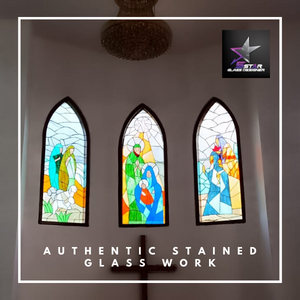The Art of Glass: Exploring Decorated Glass, Stained Glass, and Glass Design Work
Decorated glass work has been an integral part of human artistry for centuries, offering a unique blend of beauty and function. This craft involves embellishing glass surfaces through various techniques such as etching, painting, and engraving, creating intricate patterns and designs. From the grand windows of cathedrals to the elegant details on everyday items, decorated glass work is a testament to the versatility and enduring appeal of glass as a medium for artistic expression.

One of the most revered forms of decorated glass work is stained glass design work. This ancient art form dates back to the middle Ages, where it was predominantly used in churches and cathedrals to depict religious scenes and stories. The process involves cutting glass into specific shapes, which are then painted and fired to achieve vibrant colors. These pieces are assembled into a mosaic, held together by lead strips, creating a stunning visual narrative that transforms light into a spectrum of hues. Stained glass design work is not just about the depiction of religious iconography; it also includes contemporary designs that bring a touch of color and artistry into modern spaces. Today, stained glass is used in a variety of settings, including homes, offices, and public buildings, where it adds an element of sophistication and beauty.
Glass design work extends beyond stained glass to include a wide range of techniques and applications. From the delicate etching of glassware to the bold designs of architectural glass, this craft is marked by its adaptability and innovation. Glass design work can be seen in many forms, such as custom-made windows, decorative panels, and even functional items like lampshades and furniture. This versatility allows artisans to experiment with different textures, colors, and patterns, resulting in unique creations that cater to a variety of tastes and styles.

In modern architecture and interior design, decorated glass work, including stained glass and other forms of glass design work, has found renewed interest. The transparency and light-manipulating qualities of glass make it an ideal material for creating spaces that feel open and illuminated. Architects and designers often use glass to create focal points in a room, drawing attention to the artistry of the glass itself while enhancing the overall aesthetic of the space.
In conclusion, decorated glass work, including stained glass design and other forms of glass artistry, remains a vibrant and evolving art form. Whether in historical contexts or contemporary settings, the skillful manipulation of glass continues to captivate and inspire, bringing beauty and light into the spaces it adorns.
Comments
Post a Comment